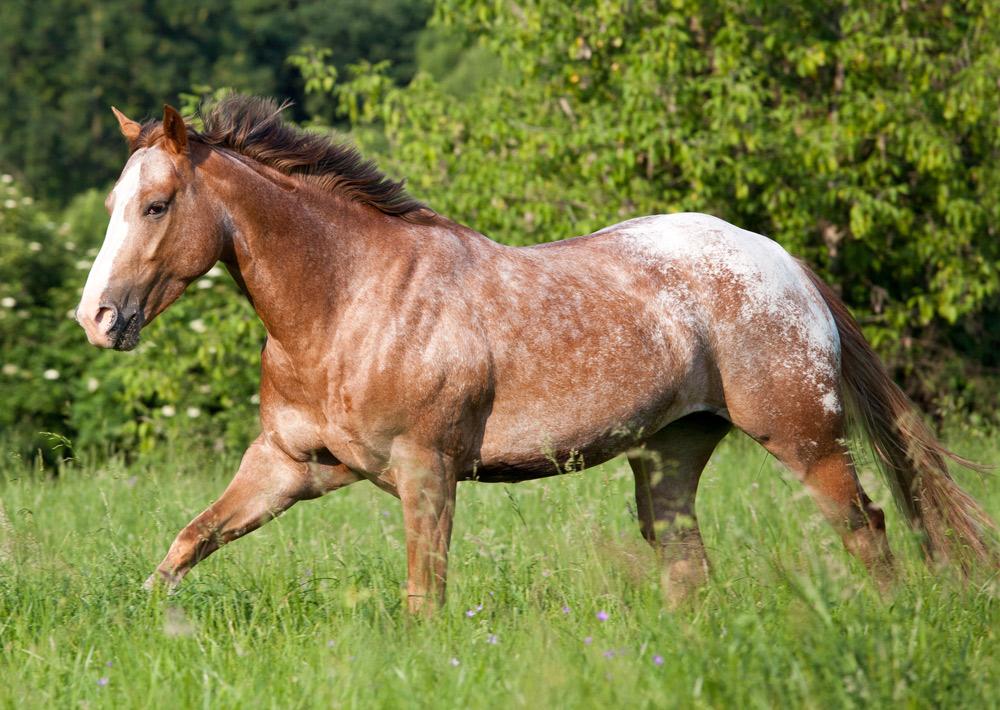Congenital Stationary Night Blindness & Leopard Complex (LP)
Gene or Region: TRPM1
Reference Variant: Normal TRPM1 (lp)
Mutant Variant: Retroviral Insertion (LP)
Affected Breeds: Several
Research Confidence: High - Similar findings in other species
Explanation of Results: LP/LP = homozygous for Congenital Stationary Night Blindness, trait expressed LP/n = heterozygous for Congenital Stationary Night Blindness, carrier n/n = no variant detected
General Description of Congenital Stationary Night Blindness & Leopard Complex
Leopard Complex Spotting (LP), also known as Appaloosa spotting, is a variant of the TRPM1 gene that results in a collect of unique pigmentation patterns. LP-associated traits include mottled skin, white sclera, striped hooves, progressive roaning, and white markings centered over the hips. The extent of white patterning present at birth is highly variable and is likely the result of multiple genetic factors. Leopard complex spotting is an example of an incomplete dominant trait, indicating that horses with one copy (LP/lp) appear different than horses with two copies (LP/LP). Within areas of white patterning, heterozygous horses (LP/lp) show fully pigmented oval spots, whereas homozygous horses (LP/LP) have few to no spots.
Congenital Stationary Night Blindness (CSNB) is a recessive disorder caused by LP. Homozygotes (LP/LP) are born with a non-progressive lack of vision in low light conditions. Horses tend to adapt very well to CSNB, and often times owners may not realize their horse has a vision problem. However, CSNB affected horses can be more prone to injury at night if a lighted area is not provided, and may be more difficult to handle in low light conditions. Coat pattern is not always sufficient to identify CSNB affected horses, especially in minimally patterned individuals, and thus genetic testing is recommended to verify a horse’s LP genotype.
Genotype and Phenotype
Double leopard with pattern-1 (LP/LP PATN1/n): Fewspot, near fewspot with CSNB Single leopard with pattern-1 (LP/lp PATN1/n): Leopard, near leopard Non-leopard with pattern-1 (lp/lp PATN1/n): No leopard complex spotting
Double leopard without pattern-1 (LP/LP patn1/patn1): Snowcap, varnish with CSNB Single leopard without pattern-1 (LP/lp patn1/patn1): Spotted blanket, varnish Non-leopard without pattern-1 (lp/lp patn1/patn1): No leopard complex spotting
- Spotting patterns generally follow after the color of the pigmented regions, for example “dun leopard” or “black silver snowcap.”
- LP associated patterning exists in the full spectrum from 0-100% white spotting, and thus does not always fit in discrete categories. We have not named all commonly used pattern classifications above, but rather have provided examples for each genotype.
- Other color variants can mask leopard spots, resulting in a LP/lp horse that appears homozygous.
- It can be difficult to visually distinguish LP/LP from LP/lp (and thus possibility of CSNB) in the lower ranges of patterning.
Gene Information
TRPM1 is a gated ion channel receptor involved in signaling in the retina and melanocytes. Mutations in other species have been associated with congenital stationary night blindness, though only the horse displays pigmentation differences. The LP mutation is a large insertion within TRPM1 that leads to absence of the protein.
##References
Bellone RR et al., “Evidence for a retroviral insertion in TRPM1 as the cause of congenital stationary night blindness and leopard complex spotting in the horse.” (2013) PLoS One. 8 :e78280. PMID: 24167615
Holl H et al., “Variant in the RFWD3 Gene Associated with PATN1, a Modifier of Leopard Complex Spotting.” (2015) Anim Genet. 47: 91-101.
Druml T et al., "Phenotypic and genetic analysis of the leopard complex spotting in Noriker horses." (2017) J Hered. doi: 10.1093/jhered/esx039.
More Horse Color Genetics
Champagne
Champagne (CH) is a dilution that affects all coat colors. Champagne foals are born with pink skin and blue eyes that slightly darken with age. Adult champagne horses have a distinct pumpkin colored skin with mottling in the hairless regions, as well as amber/green/tan eyes. Horses with multiple dilutions can be difficult to accurately identify color without genetic testing.
Cream
Cream (CR) is a dilution that is characterized by diluting or lightening both black-based and red-based horses. A single CR allele lightens red pigment to Palomino but does not overtly affect Black pigment. Two CR alleles results in extreme dilution of the hair, skin, and eyes of any color, though black-based horses tend to retain more pigment than red-based horses.
